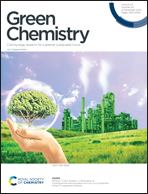On the need for gate-to-gate environmental metrics in biocatalysis: fatty acid hydration catalyzed by oleate hydratases as a case study
Abstract
Biocatalysis will play a central role in future chemical conversions, aiming at more sustainable strategies while keeping efficiency and economics. The mere use of enzymes does not ensure the greenness of a process, and quantitative environmental metrics must substantiate this. Simple but meaningful approaches are needed, particularly when reactions are still at a preliminary phase of research. This paper explores the use of the E-factor and a gate-to-gate strategy to assess environmental metrics for biocatalysis at the proof-of-concept stage. The upstream part – the actual biocatalytic reaction – and the downstream part – the purification of the product – are considered, providing the complete E-factor of the synthesis. As a case study, the hydration of oleic acid catalyzed by oleate hydratases (OHY) is used. Depending on the reaction conditions (particularly the substrate loadings), and the chosen downstream, total E-factors range from 15–20 to 160, mostly comprising wastewater (from the reaction media) and solvent (from the downstream part). The evaluation is completed with the estimation of the Total Carbon Dioxide Release (TCR), kg of CO2 per kg of product, which provides comparable data to benchmark synthetic strategies. The timely identification of hot spots (large contributors to the environmental impact) enables researchers and practitioners to propose experiments to show that biocatalysis can be performed under more sustainable conditions.



 Please wait while we load your content...
Please wait while we load your content...